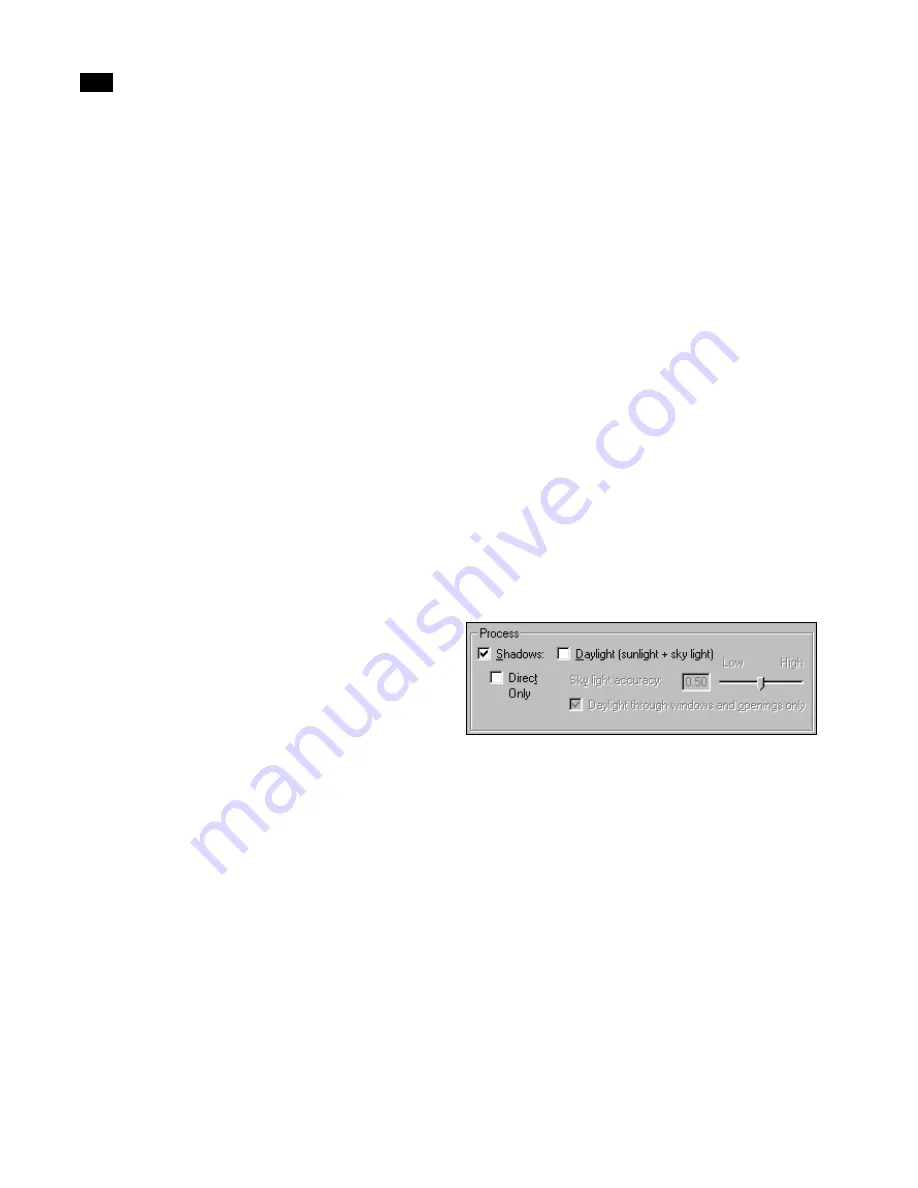
Radiosity Processing
11
176
Lightscape
Indirect Source Subdivision Accuracy
Use Indirect Source Subdivision Accuracy to control
the accuracy of how the secondary source is
computed against the rest of the surfaces in the
scene. It works in the same way as the Direct Source
Subdivision Accuracy parameter.
The recommendations made for the Direct Source
Subdivision Accuracy parameter apply to this
parameter as well. In general, you can set the indirect
sources to match the direct sources. For certain
models, or to reduce the processing time, you may
decide that indirect sources do not need to be calcu-
lated to the same level of quality as direct sources.
Shadow Grid Size
The amount of light transferred from a source to a
receiving target depends on the strength of the
source and its position and orientation with respect
to the target. It also depends on the presence of other
objects in the scene acting as obstacles between the
source and receiver.
Lightscape tries to estimate the attenuation (fall-off)
of light due to possible occlusions by casting rays
from the target toward the source. It computes the
attenuation factor as the fraction of rays cast that
actually reach the source without being blocked by
any obstacle. To control the number of rays cast
between a receiving point and a source, use the
Shadow Grid Size parameter.
For linear sources, the value of this parameter is the
number of rays cast. For area sources, indirect
sources, and windows, the system casts rays toward
a regular grid of points that are spread over the
source. This grid size is equal to the control param-
eter in each direction. In other words, the number of
rays cast is equal to the square of the value of the
control parameter.
You should increase this parameter in conjunction
with the Subdivision Accuracy parameters. Finding
the best values for these parameters requires some
experience and experimentation. For example, if
you set the Shadow Grid Size parameter to 1, the
shadow of a table cast by an area source onto a floor
always appears too sharp, no matter how much you
subdivide the mesh of the receiving surface.
Furthermore, setting the Shadow Grid Size param-
eter to a small value may not always result in faster
processing. In fact, the overly sharp shadows may
trigger unnecessary subdivisions of the receiving
surface, thus consuming more processing time and
memory.
Setting Process Parameters
Use parameters in the Process group box to control
how shadows and daylight participate in the lighting
simulation.
Shadows
Computing shadows is the most time-consuming
part of the simulation. When you run the initial tests
on a new model, you can significantly accelerate
processing by disabling the Shadows parameter.
Allowing light to go through obstacles unaffected
means the results of the computation will be incor-
rect. However, this feature can prove useful for
rapidly testing the position, orientation, and
strength of light sources in relation to the receiving
surfaces and for testing the meshing configurations
of receiving surfaces. Once you have adjusted all
these parameters, you can reset the solution, enable
Summary of Contents for LIGHTSCAPE
Page 1: ...SULO 4 31 93 36034333308355 LJKWVFDSH...
Page 18: ...NOTES 10...
Page 110: ...NOTES 102...
Page 136: ...NOTES 128...
Page 166: ...NOTES 158...
Page 176: ...NOTES 168...
Page 202: ...NOTES 194...
Page 210: ...NOTES 202...
Page 248: ...NOTES 240...
Page 294: ...NOTES 286...
Page 308: ...NOTES 300...
Page 316: ...NOTES 308...
Page 324: ...NOTES 316...
Page 342: ...Glossary 334 Lightscape...
Page 360: ...Index ix 352 Lightscape...
Page 362: ......
















































